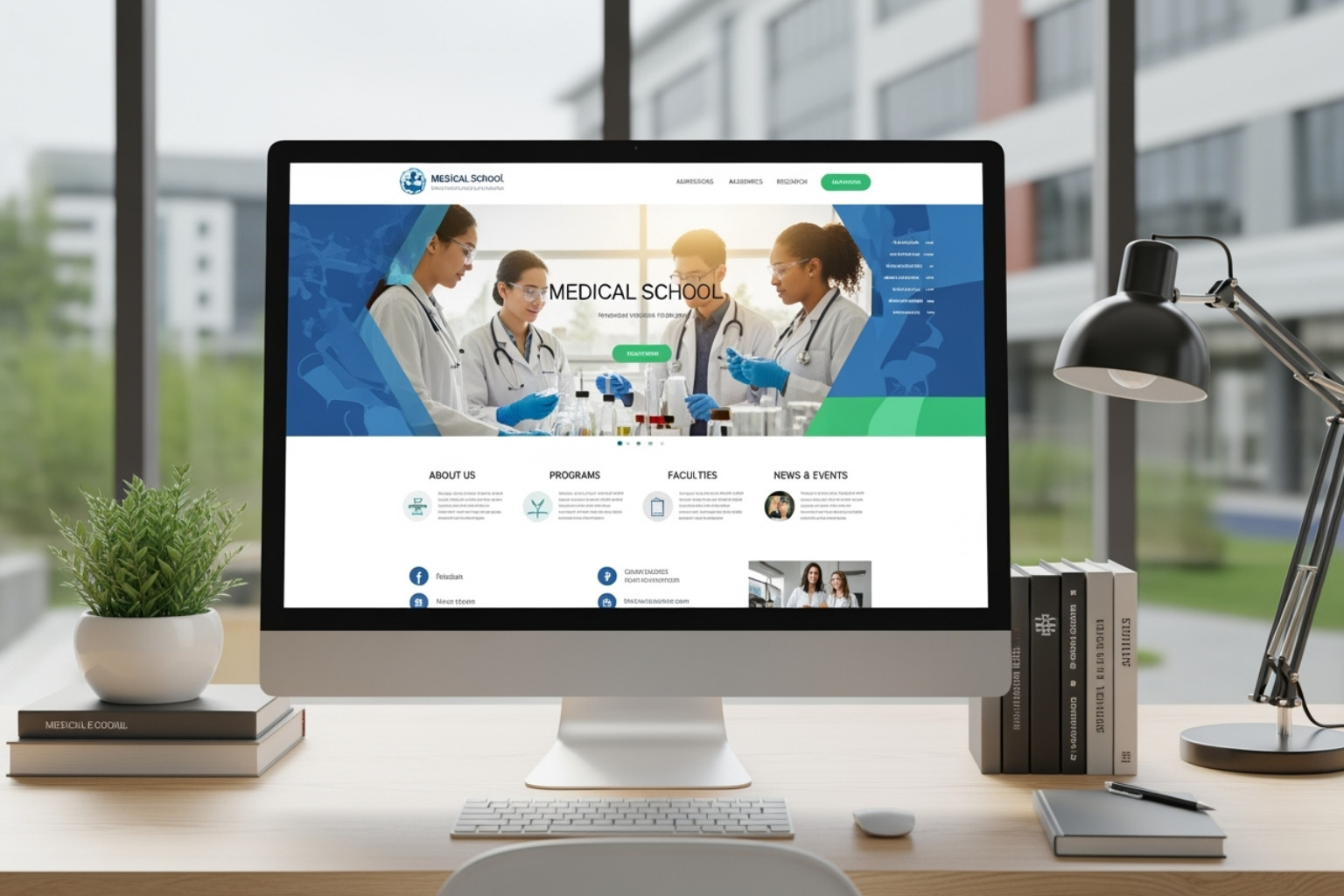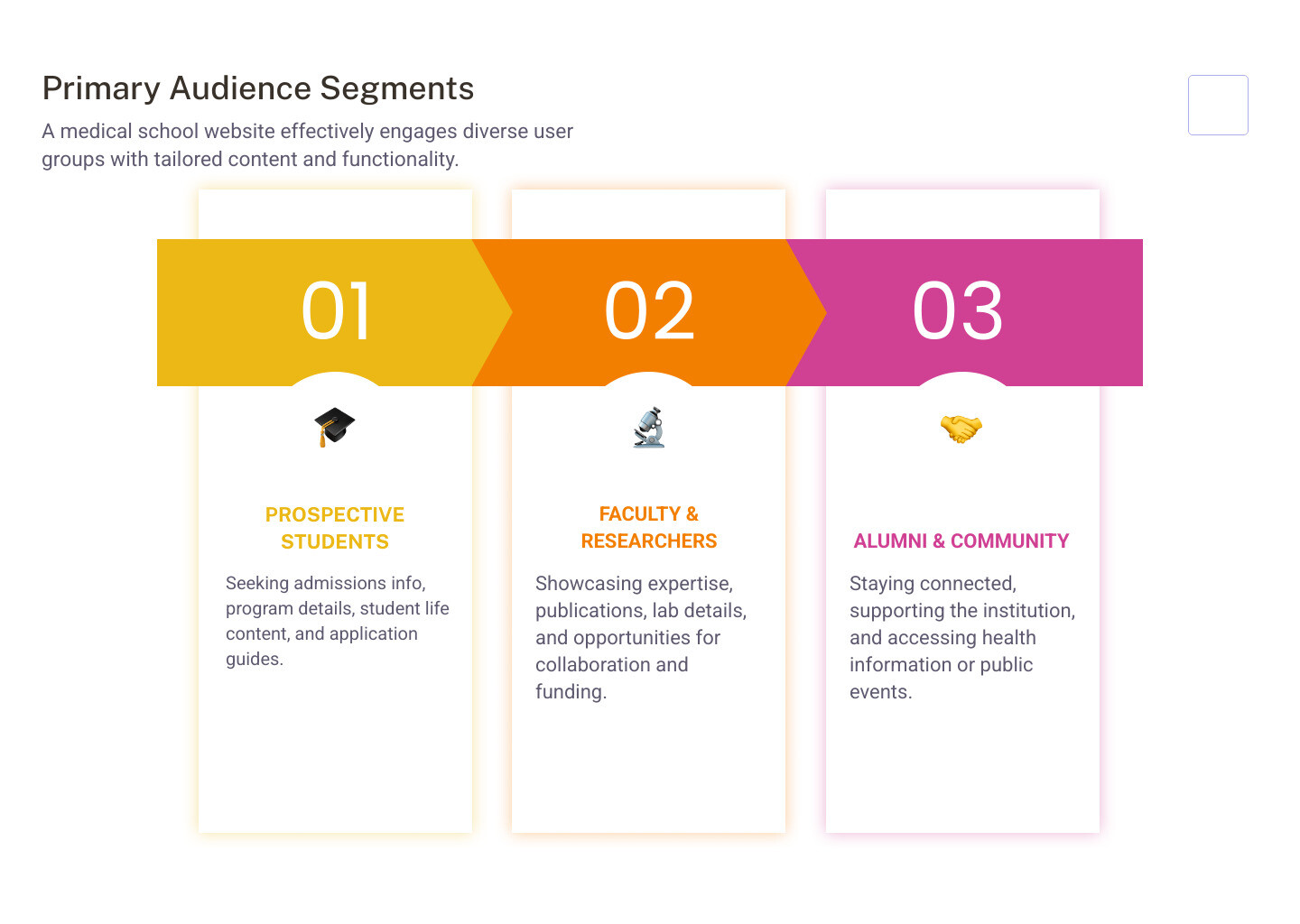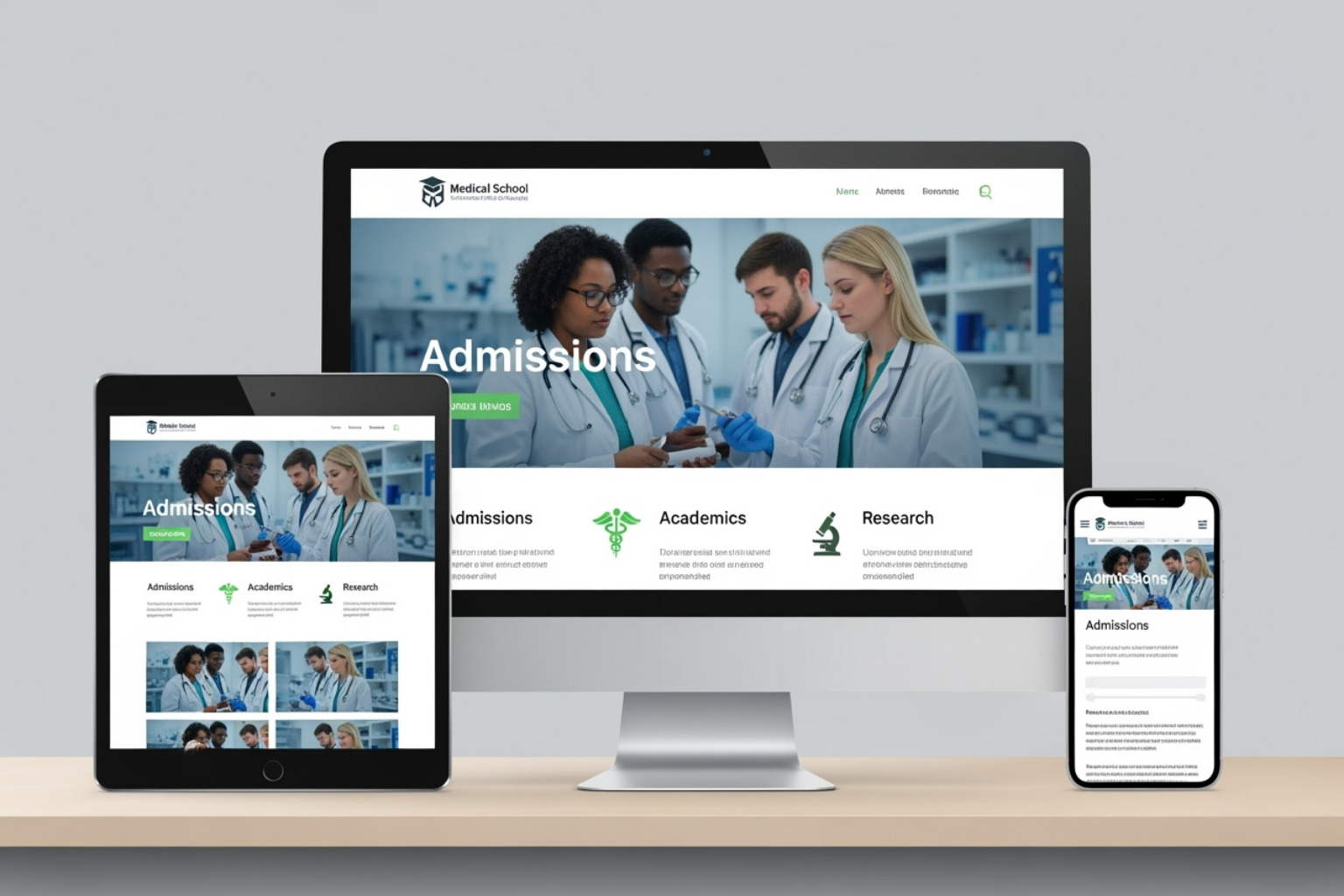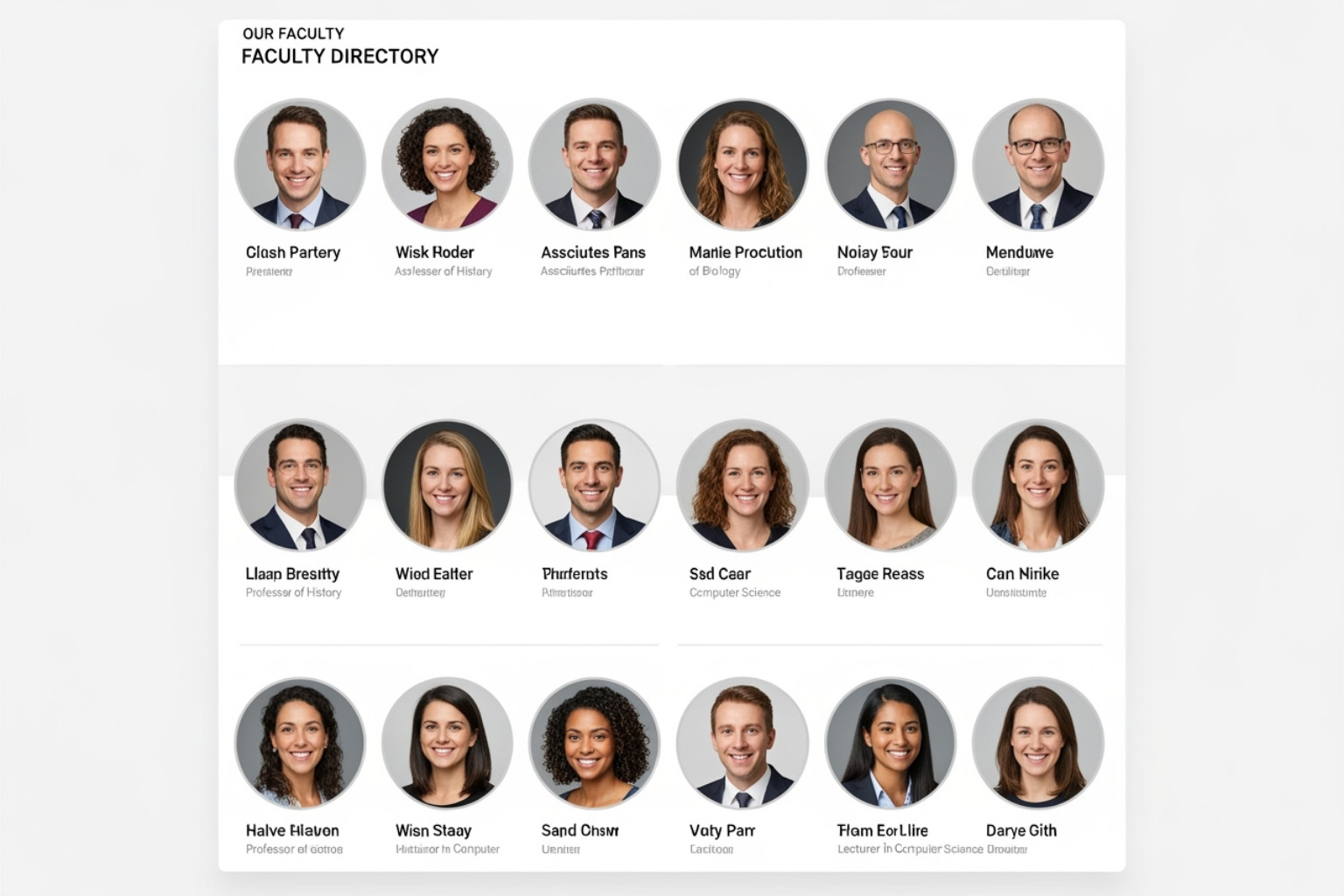Why Medical School Website Design Drives Student Enrollment Success

Medical School Website Design is a critical factor for enrollment, determining whether prospective students choose an institution or a competitor. With over a billion daily health-related Google searches, a medical school’s website is the first impression for future doctors, faculty, and community members.
Key Components of Effective Medical School Website Design:
- Clear admissions pathways – Direct application links and step-by-step guides
- Faculty expertise showcase – Detailed profiles and research highlights
- Student success stories – Match rates and alumni testimonials
- Mobile-responsive design – Optimized for all devices
- Fast loading speeds – Under 3 seconds for optimal user experience
- Accessible design – WCAG compliant for all users
- Trust-building elements – Accreditation displays and security features
Research shows that website design, clear layout, and interactive features have a positive effect on trust and credibility—critical factors when prospective students are choosing where to invest their future medical careers.
Nearly 80% of internet users search for medical and health information online before making decisions. This means a medical school’s website isn’t just a digital brochure; it’s its most powerful enrollment tool.
Brain Jar helps educational institutions create compelling online experiences that drive consistent enrollment and build lasting community trust through expert Medical School Website Design.

Defining Your Website’s Core Strategy: Goals, Audience, and Mission
A medical school’s website is its digital front door, forming opinions long before a campus visit. A core strategy begins by defining the website’s primary goals, which go far beyond just “having an online presence.” The site must serve as a recruitment tool, research showcase, and community bridge.
Attracting top-tier applicants is a central goal. Ambitious future doctors compare programs online, and the website must present a clear and compelling vision of student life and academic excellence.
Great medical schools also need distinguished faculty. A website offers the first glimpse into whether the school’s culture of innovation and academic excellence is the right professional home for renowned researchers and educators.
Securing research funding is another crucial goal. By effectively communicating research initiatives and their real-world applications, a website can open doors to grants and philanthropic donations that drive medical breakthroughs.
Finally, building community trust establishes the medical school as a reliable health resource and valued partner. This is especially vital for osteopathic medical schools that emphasize holistic care and community health.
Your website serves a diverse audience, including:
- Prospective students seeking clear admissions pathways and program details.
- Current students needing quick access to resources.
- Alumni looking for ways to connect and give back.
- Researchers exploring collaboration and grant information.
- Donors wanting to understand the school’s mission and impact.
- Community members searching for health information or clinic details.
Your website is the ideal platform for telling your story and conveying your mission. It’s where you can showcase a unique history, highlight a commitment to medical education, and demonstrate your impact on healthcare. Much like The Gates Foundation uses its site to inspire trust through impact stories, a medical school can build credibility by clearly communicating its values and achievements.
Catering to Prospective Students
Prospective students are a primary audience. Their journey often begins with online research, so the website must guide them from curiosity to application.
- Easy-to-find admissions information with clear requirements and deadlines removes barriers.
- Detailed program information highlights what makes your school special, such as three-year MD programs or unique dual-degree options.
- Student life content, including photos and testimonials, helps applicants envision their future at your institution.
- Virtual tours bring the campus to life, showcasing labs and study spaces for those who cannot visit in person.
- Clear calls-to-action like “Apply Now” or “Request Information” keep motivated prospects moving forward.
Engaging Faculty and Researchers
Your faculty’s expertise deserves a prominent showcase to attract colleagues and students.
- Faculty directories with detailed profiles, research interests, and publications serve as valuable recruitment and collaboration resources.
- Research publication sections demonstrate the institution’s contribution to medical knowledge.
- Lab websites and dedicated research pages offer a deep dive into specific specialties.
- Internal resources portals provide easy access to grants and collaborative tools.
- News and achievements celebrate faculty successes and reinforce a dynamic research environment.
Connecting with Alumni and the Community
Your school’s influence extends beyond graduation. Alumni and the local community are powerful advocates and partners.
- Alumni success stories demonstrate the value of your education and inspire prospective students.
- Streamlined donation portals make it easy for supporters to give back and fund scholarships or research.
- Community health initiatives, such as free clinics and public health campaigns, highlight your commitment to community wellbeing.
- Public events calendars invite community engagement and position your school as an accessible knowledge resource.
Implementing effective local online marketing strategies can also significantly boost engagement and enrollment from your geographic area.
Key Elements of User-Centric and Accessible Medical School Website Design
Website visitors, especially those seeking medical or educational information, are often pressed for time. Every click and second matters. This is the reality for prospective students making life-changing decisions, faculty looking for opportunities, and community members seeking health resources.
User-Centric Medical School Website Design anticipates user needs to create a seamless experience. Good design is about function, not just appearance.

The foundation of effective Medical School Website Design is User Experience (UX). Every click should feel natural, pages should load instantly, and information should be where visitors expect it.
- Intuitive navigation is the website’s compass. A prospective student researching deadlines at 2 AM shouldn’t have to hunt for admissions information. Mayo Clinic demonstrates this with prominent search functions that allow users to quickly find any topic or program.
- Simple information architecture organizes complex information into logical pathways, guiding users from general programs to specific requirements.
- Mobile-first responsiveness is essential. The website must adapt seamlessly to any screen size, ensuring an excellent experience on desktops, tablets, and smartphones.
- Fast load speeds are critical. A delay of even three seconds can send a potential applicant to a competitor. Optimized images and efficient code ensure content reaches visitors immediately.
Visual Design and Modern Trends
Visual design is a silent ambassador, communicating professionalism and innovation. It shapes subconscious decisions about trust and credibility.
- Professional imagery using authentic photos of your students, faculty, and campus tells a more powerful story than generic stock photos. Maven Clinic uses original photography that matches its brand and establishes credibility.
- Consistent branding (logo, colors, fonts) reinforces your institution’s identity and builds trust. The National Women’s Health Network exemplifies this with bold, consistent branding.
- Clean layouts and strategic white space help important information stand out, creating a sophisticated, easy-to-steer experience. Root Functional Medicine showcases this with its clean layout and calming color palette.
- Bold typography improves readability and creates a contemporary aesthetic.
- Video backgrounds and interactive elements, when used thoughtfully, can create memorable experiences without being overwhelming. Drawing inspiration from Cleveland Clinic’s welcoming design shows how clean layouts guide visitors naturally.
Accessibility, Legal, and Ethical Considerations
In healthcare education, accessibility and legal compliance are fundamental responsibilities. A medical school website must welcome everyone and meet the highest ethical standards.
- WCAG compliance ensures the site works for visitors with disabilities. Following Web Content Accessibility Guidelines (WCAG) makes a site perceivable, operable, understandable, and robust for all. Rest Assured® demonstrates this by building its site to WCAG 2.2 AA compliance.
- ADA standards compliance protects your institution from legal risks and fosters an inclusive environment.
- Data privacy regulations like GDPR and CCPA require transparent policies and secure data handling, which is critical when collecting applicant information.
- Secure forms with SSL certificates encrypt personal information. The lock icon in the browser signals to visitors that their sensitive data is protected.
Understanding HIPAA and HITECH compliance is crucial when a website handles any health information, ensuring the highest standards of privacy.
Crafting Compelling Content to Build Trust and Showcase Expertise
Effective Medical School Website Design relies on compelling content. The words on your website become the voice of your institution, speaking directly to future doctors, researchers, and community members who are evaluating your school’s credibility.
Prospective students are not just choosing a school; they are investing in their entire medical career. Every piece of content either builds confidence in your program or creates doubt.

- Showcasing unique programs means painting a vivid picture of what makes your educational approach different, whether it’s early clinical experience or integrated technology.
- Highlighting faculty expertise with detailed profiles that include research passions and teaching philosophies gives visitors a glimpse into the minds that will shape their education.
- Communicating research initiatives requires translating complex science into inspiring language that explains why the work matters to patients and the future of medicine.
For institutions looking to create comprehensive online experiences, a web development services complete guide covers all aspects of building powerful websites that convert visitors.
Highlighting Academic and Program Excellence
Prospective students research what they will learn, how they will learn it, and what kind of doctors they will become. Your content must provide these answers.
- Detailed curriculum pages should be engaging previews of your course structures and clinical rotations, helping students envision themselves mastering the material.
- Showcasing innovative teaching methods, like simulation labs or problem-based learning, demonstrates that your school is at the forefront of medical education.
- Highlighting unique degrees is crucial in a competitive landscape. NYU Langone transformed medical education with its three-year MD program and ensures every visitor understands its benefits.
- Student outcomes and match rates, including USMLE pass rates and residency match statistics, provide concrete evidence of your program’s effectiveness.
Building Credibility with Multimedia and Stories
Credibility comes from impressive statistics and authentic human stories that demonstrate real-world impact.

- Virtual campus tours are essential for reaching students who cannot visit in person, allowing them to explore labs, research centers, and student spaces.
- Video interviews with faculty create personal connections. Hearing the passion in a professor’s voice as they describe their research can influence enrollment decisions.
- Alumni success stories serve as powerful proof of your educational quality, showing the possibilities that await graduates.
- Patient testimonials from affiliated clinics add another layer of credibility by demonstrating the real-world impact of your institution’s clinical work.
Using video for storytelling, much like Hartford HealthCare does, gives visitors control over their experience while building deeper emotional connections to your institution’s mission.
Essential Features for High-Conversion Pages
Certain pages within your Medical School Website Design do more than inform—they inspire action. These high-conversion pages are where prospective students decide to apply, alumni choose to donate, and faculty see themselves joining your team.
Think of these pages as digital enrollment counselors. They must be persuasive, clear, and remove every barrier between a visitor and their next step. The most critical conversion pages include the admissions section, alumni portal, news and events section, and the giving/donation page.
Your admissions page carries the heaviest load. To make it effective, it needs:
- Clear eligibility requirements to help qualified students see themselves succeeding.
- A step-by-step application guide to break down the process into manageable actions.
- Prominent application portal links that are impossible to miss.
- Key dates and deadlines displayed clearly.
- Financial aid and scholarship information to address affordability concerns.
- A comprehensive admissions FAQ section to address common questions.
The Admissions and Application Portal
Your admissions portal is where dreams meet reality. This section of your Medical School Website Design must feel both professional and welcoming.
- Direct application links should be prominently placed, making it effortless for a visitor to take the next step.
- Downloadable forms and guides serve as helpful companions for applicants who prefer offline materials.
- Financial aid calculators transform abstract tuition numbers into concrete, personal information, making the path forward less intimidating.
- Contact information for admissions counselors provides a crucial human touch for applicants with specific questions.
The Research and Publications Section
Your research section showcases the intellectual powerhouse behind your medical education. This is where you demonstrate that your faculty doesn’t just teach medicine—they advance it.
- A searchable database of publications allows visitors to explore the depth of your institution’s contributions to medical knowledge.
- Profiles of research centers and institutes give personality and focus to your research efforts, showing the dedicated teams driving findy.
- Information on clinical trials serves multiple audiences, from prospective students to community members and potential collaborators.
- Faculty research interests, when clearly presented, help match students with mentors and attract like-minded researchers to your institution.
A study on what builds website trust confirms that well-organized, professional research sections significantly improve institutional credibility, which is vital for enrollment and funding decisions.
Technical Foundations: SEO, Performance, and Analytics
Think of your Medical School Website Design as a high-performance vehicle. It might look stunning, but if the engine is sluggish or no one can find it, it won’t achieve its goals. The technical foundation of your website makes everything else possible.
Several Key Performance Indicators (KPIs) are tracked to ensure the website is working for your institution:
- Your application conversion rate measures how many visitors submit applications and is a primary metric for success.
- Time on page reveals if visitors are engaging with content about programs, faculty, and campus life.
- The bounce rate shows if visitors are finding what they need or leaving immediately, indicating potential issues with navigation or content.
- Keyword rankings determine if your school appears in relevant searches like “osteopathic medical school” or “MD programs near me.”
These metrics paint a complete picture of website effectiveness. To complement organic performance, schools can use comprehensive ad campaign management to expand their digital reach.
The Role of SEO in Medical School Website Design
If prospective students can’t find your medical school online, they can’t apply. Medical School Website Design and SEO are two sides of the same coin.
- Your keyword strategy must align with how your audience searches. This includes terms like “best osteopathic medical schools,” “MD programs with high match rates,” or “medical school scholarships.”
- On-page optimization involves weaving these keywords naturally into page titles, descriptions, and content.
- Schema markup acts as a roadmap for search engines, helping them understand your content and feature it in rich search results with course details or event information.
- Local SEO is vital, as many students search within a specific geographic region. Appearing in location-based results for searches like “medical schools in California” is crucial.
An SEO Services Gold Plan can provide comprehensive optimization to help educational institutions increase visibility and attract qualified applicants.
Website Maintenance and Performance
A medical school website requires constant care to remain vibrant and secure. It is a living digital campus.
- Regular CMS updates are like maintaining campus buildings; they prevent security vulnerabilities and ensure smooth functionality.
- Security protocols and monitoring are necessities, not luxuries. Robust firewalls, SSL certificates, and continuous monitoring protect sensitive student, faculty, and donor data.
- Daily backups provide peace of mind, allowing for quick restoration in case of a server crash or accident.
- Performance optimization ensures your site loads quickly on any device. A slow-loading site can cause a prospective student to move on to a competitor.
Frequently Asked Questions about Medical School Website Design
Administrators and marketing teams often have common questions about Medical School Website Design. Choosing the right digital strategy is a major decision affecting everything from student enrollment to faculty recruitment. Here are straightforward answers to the most frequent inquiries.
What are the primary goals of a medical school website?
A medical school website is a 24/7 enrollment tool. Its primary goal is to attract and convert prospective students who are a good fit for the programs. Other key goals include recruiting high-quality faculty, showcasing research leadership to attract grant funding, engaging alumni and donors to ensure long-term sustainability, and serving as a credible health resource for the community.
How can a medical school website build trust with visitors?
Trust is built through a combination of elements. It starts with professional, modern design that signals high standards. Trust is further established by showcasing faculty expertise through detailed profiles and publications, publishing transparent information like match rates and accreditation status, and sharing student and alumni success stories as social proof. Technical elements like SSL certificates (for security) and WCAG compliance (for accessibility) also send important trust signals.
What is the most important element for a user-friendly design?
The single most important element is intuitive navigation. If visitors cannot find what they are looking for quickly, all other design aspects become irrelevant. A stressed pre-med student or a busy researcher needs to locate information with minimal clicks. Navigation should be organized logically with clear, familiar categories like “Admissions,” “Programs,” and “Faculty.” It must also be fully responsive, working flawlessly on any device, from a desktop computer to a smartphone.
Conclusion
Your Medical School Website Design journey is an ongoing commitment to excellence, evolving with your institution and the digital landscape. A strategic foundation of clear goals, user-centric design, compelling content, and a robust technical infrastructure creates a digital presence that serves your school’s mission. When your website connects prospective students, faculty, and alumni, it becomes the central hub for these vital relationships.
The future of medical school websites is bright, moving toward more interactive experiences, personalized content, and data-driven insights that measure enrollment success. These advances will help you tell your unique story more effectively, celebrating the distinctive qualities that define your institution while making it effortless for visitors to find what they need.
Brain Jar understands the unique challenges facing vocational schools, career colleges, and specialty educational institutions. A well-designed website can transform enrollment numbers and strengthen community connections. The agency’s expertise in web development, SEO, social media management, video production, and paid advertising campaigns comes together to create comprehensive digital strategies that deliver real results.
Your medical school deserves a website that works as hard as you do to shape the future of healthcare. It should be a place where future doctors feel inspired, current students find resources to succeed, and the community recognizes your institution as a trusted leader.
Ready to create a digital presence that reflects your medical school’s excellence? Contact us to build a website that attracts your next generation of medical leaders today.
